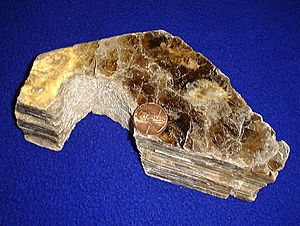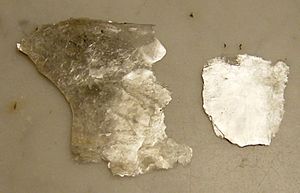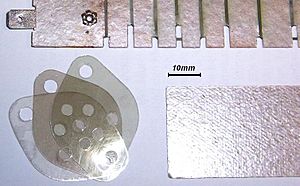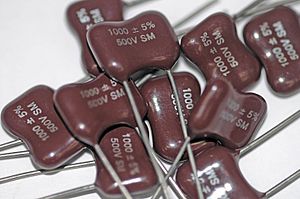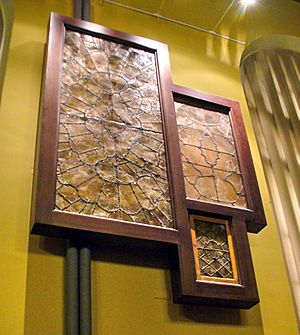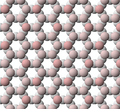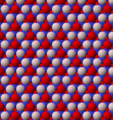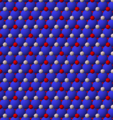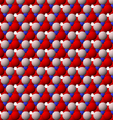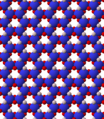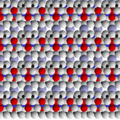Mica facts for kids
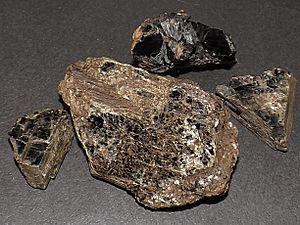
The mica group of minerals are aluminosilicates with various metals. They split into fine sheets.
Mica includes several closely related materials having perfect basal cleavage.
All are monoclinic which means their crystals are shaped like one kind of prism. They tend towards pseudo-hexagonal crystals and are similar in chemical composition. The highly perfect cleavage, which is the most prominent characteristic of mica, is explained by the hexagonal sheet-like arrangement of its atoms.
Contents
Properties and uses
The mica group represents 37 phyllosilicate minerals that have a layered or platy texture. The commercially important micas are muscovite and phlogopite, which are used in a variety of applications. Mica’s value is based on several of its unique physical properties. The crystalline structure of mica forms layers that can be split or delaminated into thin sheets usually causing foliation in rocks. These sheets are chemically inert, dielectric, elastic, flexible, hydrophilic, insulating, lightweight, platy, reflective, refractive, resilient, and range in opacity from transparent to opaque. Mica is stable when exposed to electricity, light, moisture, and extreme temperatures. It has superior electrical properties as an insulator and as a dielectric, and can support an electrostatic field while dissipating minimal energy in the form of heat; it can be split very thin (0.025 to 0.125 millimeters or thinner) while maintaining its electrical properties, has a high dielectric breakdown, is thermally stable to 500 °C (932 °F), and is resistant to corona discharge. Muscovite, the principal mica used by the electrical industry, is used in capacitors that are ideal for high frequency and radio frequency. Phlogopite mica remains stable at higher temperatures (to 900 °C (1,650 °F)) and is used in applications in which a combination of high-heat stability and electrical properties is required. Muscovite and phlogopite are used in sheet and ground forms.
Ground mica
The leading use of dry-ground mica in the US is in the joint compound for filling and finishing seams and blemishes in gypsum wallboard (drywall). The mica acts as a filler and extender, provides a smooth consistency, improves the workability of the compound, and provides resistance to cracking. In 2008, joint compound accounted for 54% of dry-ground mica consumption. In the paint industry, ground mica is used as a pigment extender that also facilitates suspension, reduces chalking, prevents shrinking and shearing of the paint film increases the resistance of the paint film to water penetration and weathering and brightens the tone of colored pigments. Mica also promotes paint adhesion in aqueous and oleoresinous formulations. Consumption of dry-ground mica in paint, the second-ranked use, accounted for 22% of the dry-ground mica used in 2008.
Ground mica is used in the well-drilling industry as an additive to drilling fluids. The coarsely ground mica flakes help prevent the loss of circulation by sealing porous sections of the drill hole. Well drilling muds accounted for 15% of dry-ground mica use in 2008. The plastics industry used dry-ground mica as an extender and filler, especially in parts for automobiles as lightweight insulation to suppress sound and vibration. Mica is used in plastic automobile fascia and fenders as a reinforcing material, providing improved mechanical properties and increased dimensional stability, stiffness, and strength. Mica-reinforced plastics also have high-heat dimensional stability, reduced warpage, and the best surface properties of any filled plastic composite. In 2008, consumption of dry-ground mica in plastic applications accounted for 2% of the market. The rubber industry used ground mica as an inert filler and mold release compound in the manufacture of molded rubber products such as tires and roofing. The platy texture acts as an anti-blocking, anti-sticking agent. Rubber mold lubricant accounted for 1.5% of the dry-ground mica used in 2008. As a rubber additive, mica reduces gas permeation and improves resiliency.
Dry-ground mica is used in the production of rolled roofing and asphalt shingles, where it serves as a surface coating to prevent sticking of adjacent surfaces. The coating is not absorbed by freshly manufactured roofing because mica’s platy structure is unaffected by the acid in asphalt or by weather conditions. Mica is used in decorative coatings on wallpaper, concrete, stucco, and tile surfaces. It also is used as an ingredient in flux coatings on welding rods, in some special greases, and as coatings for core and mold release compounds, facing agents, and mold washes in foundry applications. Dry-ground phlogopite mica is used in automotive brake linings and clutch plates to reduce noise and vibration (asbestos substitute); as sound-absorbing insulation for coatings and polymer systems; in reinforcing additives for polymers to increase strength and stiffness and to improve stability to heat, chemicals, and ultraviolet (UV) radiation; in heat shields and temperature insulation; in industrial coating additive to decrease the permeability of moisture and hydrocarbons; and in polar polymer formulations to increase the strength of epoxies, nylons, and polyesters.
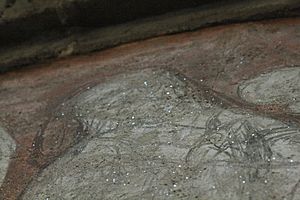
Wet-ground mica, which retains the brilliance of its cleavage faces, is used primarily in pearlescent paints by the automotive industry. Many metallic-looking pigments are composed of a substrate of mica coated with another mineral, usually titanium dioxide (TiO2). The resultant pigment produces a reflective color depending on the thickness of the coating. These products are used to produce automobile paint, shimmery plastic containers, high-quality inks used in advertising and security applications. In the cosmetics industry, its reflective and refractive properties make mica an important ingredient in blushes, eye liner, eye shadow, foundation, hair and body glitter, lipstick, lip gloss, mascara, moisturizing lotions, and nail polish. Some brands of toothpaste include powdered white mica. This acts as a mild abrasive to aid polishing of the tooth surface, and also adds a cosmetically pleasing, glittery shimmer to the paste. Mica is added to latex balloons to provide a colored shiny surface.
Mica is also used as an insulator in concrete block and home attics and can be poured into walls (usually in retrofitting uninsulated open top walls). Mica may also be used as a soil conditioner, especially in potting soil mixes and in gardening plots. Greases used for axles are composed of a compound of fatty oils to which mica, tar or graphite is added to increase the durability of the grease and give it a better surface.
Built-up mica
Muscovite and phlogopite splittings can be fabricated into various built-up mica products. Produced by mechanized or hand setting of overlapping splittings and alternate layers of binders and splittings, built-up mica is used primarily as an electrical insulation material. Mica insulation is used in high-temperature and fire-resistant power cables in aluminium plants, blast furnaces, critical wiring circuits (for example, defense systems, fire and security alarm systems, and surveillance systems), heaters and boilers, lumber kilns, metal smelters, and tanks and furnace wiring. Specific high-temperature mica-insulated wire and cable is rated to work for up to 15 minutes in molten aluminium, glass, and steel. Major products are bonding materials; flexible, heater, molding, and segment plates; mica paper; and tape.
Flexible plate is used in electric motor and generator armatures, field coil insulation, and magnet and commutator core insulation. Mica consumption in flexible plate was about 21 tonnes in 2008 in the US. Heater plate is used where high-temperature insulation is required. Molding plate is sheet mica from which V-rings are cut and stamped for use in insulating the copper segments from the steel shaft ends of a commutator. Molding plate is also fabricated into tubes and rings for insulation in armatures, motor starters, and transformers. Segment plate acts as insulation between the copper commutator segments of direct-current universal motors and generators. Phlogopite built-up mica is preferred because it wears at the same rate as the copper segments. Although muscovite has a greater resistance to wear, it causes uneven ridges that may interfere with the operation of a motor or generator. Consumption of segment plate was about 149 t in 2008 in the US. Some types of built-up mica have the bonded splittings reinforced with cloth, glass, linen, muslin, plastic, silk, or special paper. These products are very flexible and are produced in wide, continuous sheets that are either shipped, rolled, or cut into ribbons or tapes, or trimmed to specified dimensions. Built-up mica products may also be corrugated or reinforced by multiple layering. In 2008, about 351 t of built-up mica was consumed in the US, mostly for molding plates (19%) and segment plates (42%).
Sheet mica
Technical grade sheet mica is used in electrical components, electronics, in atomic force microscopy and as window sheets. Other uses include diaphragms for oxygen-breathing equipment, marker dials for navigation compasses, optical filters, pyrometers, thermal regulators, stove and kerosene heater windows, radiation aperture covers for microwave ovens, and micathermic heater elements. Mica is birefringent and is therefore commonly used to make quarter and half wave plates. Specialized applications for sheet mica are found in aerospace components in air-, ground-, and sea-launched missile systems, laser devices, medical electronics and radar systems. Mica is mechanically stable in micrometer-thin sheets which are relatively transparent to radiation (such as alpha particles) while being impervious to most gases. It is therefore used as a window on radiation detectors such as Geiger-Müller tubes.
In 2008, mica splittings represented the largest part of the sheet mica industry in the United States. Consumption of muscovite and phlogopite splittings was about 308 t in 2008. Muscovite splittings from India accounted for essentially all US consumption. The remainder was primarily imported from Madagascar.
Small squared pieces of sheet mica are also used in the traditional Japanese Kodo ceremony to burn incense: A burning piece of coal is placed inside a cone made of white ash. The sheet of mica is placed on top, acting as a separator between the heat source and the incense, in order to spread the fragrance without burning it.
Electrical and electronic
Sheet mica is used principally in the electronic and electrical industries. Its usefulness in these applications is derived from its unique electrical and thermal properties and its mechanical properties, which allow it to be cut, punched, stamped, and machined to close tolerances. Specifically, mica is unusual in that it is a good electrical insulator at the same time as being a good thermal conductor. The leading use of block mica is as an electrical insulator in electronic equipment. High-quality block mica is processed to line the gauge glasses of high-pressure steam boilers because of its flexibility, transparency, and resistance to heat and chemical attack. Only high-quality muscovite film mica, which is variously called India ruby mica or ruby muscovite mica, is used as a dielectric in capacitors. The highest quality mica film is used to manufacture capacitors for calibration standards. The next lower grade is used in transmitting capacitors. Receiving capacitors use a slightly lower grade of high-quality muscovite.
Mica sheets are used to provide structure for heating wire (such as in Kanthal or Nichrome) in heating elements and can withstand up to 900 °C (1,650 °F).
Peepholes
Thin transparent sheets of mica were used for peepholes in boilers, lanterns, stoves, and kerosene heaters because they were less likely to shatter than glass when exposed to extreme temperature gradients. Such peepholes were also used in "isinglass curtains" in horse-drawn carriages and early 20th-century cars.
Atomic force microscopy
Another use of mica is as a substrate in the production of ultraflat, thin-film surfaces, e.g. gold surfaces. Although the deposited film surface is still rough due to deposition kinetics, the back side of the film at the mica-film interface is ultraflat once the film is removed from the substrate. Freshly-cleaved mica surfaces have been used as clean imaging substrates in atomic force microscopy, enabling for example the imaging of bismuth films, plasma glycoproteins, membrane bilayers, and DNA molecules.
Early history
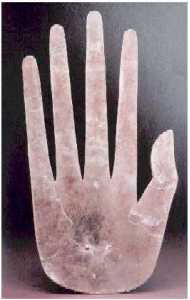
Human use of mica dates back to prehistoric times. Mica was known to ancient Indian, Egyptian, Greek and Roman and Chinese civilizations, as well as the Aztec civilization of the New World.
The earliest use of mica has been found in cave paintings created during the Upper Paleolithic period (40,000 BC to 10,000 BC). The first hues were red (iron oxide, hematite, or red ochre) and black (manganese dioxide, pyrolusite), though black from juniper or pine carbons has also been discovered. White from kaolin or mica was used occasionally.
A few kilometers northeast of Mexico City stands the ancient site of Teotihuacan. The most striking structure of Teotihuacan is the towering Pyramid of the Sun. The pyramid contained considerable amounts of mica in layers up to 30 cm (12 in) thick.
Natural mica was and still is used by the Taos and Picuris Pueblos Indians in north-central New Mexico to make pottery. The pottery is made from weathered Precambrian mica schist, and has flecks of mica throughout the vessels. Tewa Pueblo pottery is made by coating the clay with mica to provide a dense, glittery micaceous finish over the entire object.
Mica flakes (called abrak in Urdu and written as ابرک) are also used in Pakistan to embellish women's summer clothes, especially dupattas (long light-weight scarves, often colorful and matching the dress). Thin mica flakes are added to a hot starch water solution, and the dupatta is dipped in this water mixture for 3–5 minutes. Then it is hung to air dry.
Mica powder
Throughout the ages, fine powders of mica have been used for various purposes, including decorations. Powdered mica glitter is used to decorate traditional water clay pots in India, Pakistan and Bangladesh; it is also used on traditional Pueblo pottery, though not restricted to use on water pots in this case. The gulal and abir (colored powders) used by North Indian Hindus during the festive season of Holi contain fine crystals of mica to create a sparkling effect. The majestic Padmanabhapuram Palace, 65 km (40 mi) from Trivandrum in India, has colored mica windows. Mica powder is also used as a decoration in traditional Japanese woodblock printmaking, as when applied to wet ink and allowed to dry it sparkles and reflects light.
Images for kids
See also
 In Spanish: Mica para niños
In Spanish: Mica para niños


